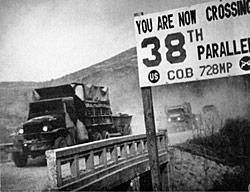Korean War: 1950-1953

The 38th Parallel Crossing [1]
The Korean War was a military conflict that resulted from the physical division of Korea by an agreement of the victorious Allies at the conclusion of the Pacific War at the end of World War II. The Korean peninsula had been ruled by Japan from 1910 until the end of World War II. After the Japanese surrender in 1945, U.S. administrators divided the peninsula country along the 38th Parallel, with U.S. troops occupying the southern part and troops from the U.S.S.R. occupying the northern part.
The North established a communist government in response to a United Nations-sponsored "national election" for the whole Korean Peninsula held in South Korea in 1948. The 38th Parallel increasingly became a political border between the two Koreas.
Despite the fact that reunification negotiations continued in the months preceding the Korean War, tensions increased. Stalin encouraged the Soviet-equipped forces of the Democratic People's Republic of Korea (North Korea) to invade South Korea. North Korean forces invaded South Korea on June 25, 1950 and the situation escalated into open warfare.
Forces from the U.S. and other members of the United Nations came to the aid of South Korea. The U.S.S.R. supplied military arms, but avoided direct participation in this conflict. China, however, intervened militarily on behalf of North Korea.
Korean war over time, showing North Korean, Chinese and communist forces in red and South Korean, U.S. and United Nations forces in green. [2]
The Korean War was the first significant armed conflict of the Cold War. With both North and South Korea sponsored by external powers, the Korean War can be considered a proxy war, a war that results when opposing powers use third parties as substitutes for fighting each other directly.
Outcomes:
- The "Korean War" inspired the U.S. both to increase military capability and to conclude a peace treaty and security pact with Japan.
- China's independent participation in the conflict also strengthened China's position as an independent world country.
- The war ended with an armistice in 1953 that restored the border between the Koreas near the 38th Parallel; the armistice also created the 2.5-mile wide Korean Demilitarized Zone between the North Korea and South Korea. Minor outbreaks of fighting continue between the two countries.
Page Notes:
[1] Source: This image from http://en.wikipedia.org/wiki/File:Crossing_the_38th_parallel.jpg is in the public domain.

